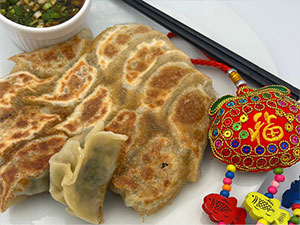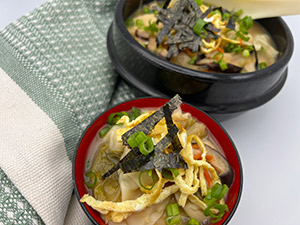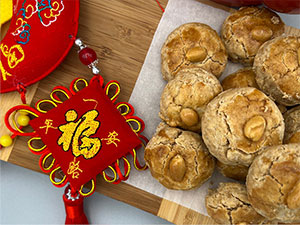Lunar New Year treats for luck and health

These lucky peanut cookies are high in protein and fiber, which can keep you feeling full longer. Photos by Jessica Van Roo
Lunar New Year 2023 observances begin Jan. 22 and last through Feb. 5, ushering in the Year of the Rabbit, more specifically the Water Rabbit — a symbol of longevity, peace and prosperity in Chinese culture.
For many countries across Asia — China, Taiwan, Vietnam, North and South Korea, Malaysia, Singapore, the Philippines, Mongolia and Indonesia — Lunar New Year is the most important holiday of all. But celebrations now take place around the world, especially in diverse places like our own Orange County, where one-fifth of the population is of Asian descent.
Rituals may vary somewhat from culture to culture, country to country, but all are connected by a common purpose — to celebrate the importance of being with family, of reuniting with relatives, especially those you haven’t seen in a while. Not surprisingly, at the heart of these gatherings are special dishes.
"Traditional foods eaten during Lunar New Year represent good fortune, wealth and luck for the year ahead," says Katie Rankell, a registered dietitian and program director of the UCI Health Weight Management Program. For example, noodles symbolize longevity. Whole fish represents abundance, dumplings mean wealth and sticky rice cakes — Nian gao, or "year" cake in Chinese — promise ever increasing prosperity.
Get ready to celebrate with this sampler of essential Lunar New Year recipes given a healthier spin by Jessica VanRoo, executive chef of the Susan Samueli Integrative Health Institute, part of UCI Health.
Vegetarian Dumplings with Sesame Dipping Sauce
Serves 6 (Total cost: $9.94/$2.46 per serving)
Calories: 300 per serving (about 8 dumplings)

Dumplings (aka potstickers) are indispensable for Lunar New Year celebrations in China. They are made in the shape of China’s ancient money — gold ingots — and are eaten to ensure wealth and prosperity in the year ahead. This vegetarian version also promises good health!
Cabbage, a key ingredient, adds fiber and keeps the calorie count low. It also offers an impressive volume of nutrients and antioxidants, including sulforaphane and kaempferol to help to reduce chronic inflammation, vitamin C to help boost your immune system and potassium to help regulate blood pressure.
Shiitake, one of the most popular mushrooms worldwide, have a rich, savory taste. They also contain compounds that may help fight cancer, boost immunity and support heart health. Wood ear mushrooms add a delicate flavor and texture to these dumplings, but they also are high in soluble fiber, protein and omega fatty acids and antioxidants.
If you are up for the challenge, try making your own gyoza wrappers. Your dumplings will taste fresher, the dough will be easier to fill plus you'll avoid preservatives. Using whole wheat wrappers boosts the nutritional value substantially — providing three times the fiber, iron and potassium found in white flour, and double the calcium!
Ingredients
|
Dumplings
|
Sesame dipping sauce
Homemade whole wheat gyoza wrappers (optional)
|
Directions
- Toss minced cabbage and chives in colander, sprinkle with ½ tablespoon of salt and allow to stand for 20 minutes.
- Place the cabbage and chive mixture in the middle of a large piece of cheesecloth and squeeze out as much liquid as possible.
- Heat a medium skillet and add oil, mushrooms and bean curd. Stir fry about 30 seconds.
- Turn off heat, add cellophane noodles, the cabbage and chive mixture and stir.
- Add soy sauce, rice wine, black pepper, sesame oil and salt to taste.
- Place 1 teaspoon of cooled filling mix in the center of each gyoza wrapper, lift and bring the edges together to create a half-moon shape.
- Pinch edges together making about 5 pleats to create a sealed pouch.
- Heat nonstick skillet, add ½ tablespoon of vegetable oil and place dumplings in a single layer in the pan.
- Fry 2 minutes or until bottoms are golden brown.
- Pour ⅓ to ½ cup water, mixed with 1 tablespoon of cornstarch over the dumplings, cover, cook 6 to 7 minutes or until the water is absorbed.
- Repeat with remaining dumplings.
- Whisk all sauce ingredients together in a separate bowl and refrigerate until needed.
Homemade whole wheat gyoza wrappers
- Place flour in large bowl, make a well in the center and slowly add boiling water, blending flour with a fork or chopsticks.
- Cover bowl with plastic wrap or towel, let stand for 15 minutes.
- Divide dough into 36 ball-shaped pieces, then use a rolling pin to flatten each ball into 4-inch diameter circles.
- Wet the edges of each wrapper with cold water, place 1-2 teaspoons of filling in the center.
- Lift edges, folding them together to form a half-moon shape. Pinch edges together to seal.
Vegetarian Rice Cake Soup
Serves 6 (Total cost: $12.75/$3.19 per serving)
Calories: 256 (per 1½ cup serving)

Tteokguk, or rice cake soup, is a delicious and filling soup made with disc-shaped rice cakes in a clear broth. Koreans eat it on Seollal, the first day of the lunar calendar.
The whiteness of the soup symbolizes a clean, fresh start. The disc-shaped rice cakes are meant to resemble coins. Together, they represent a wish for a prosperous year for anyone who eats them. By Korean tradition, everyone ages up one year on Seollal, but the process isn’t complete until you eaten a bowl of tteokguk!
Rice cake soup also includes cabbage and shitake mushrooms. Carrots add a vibrant orange pop of color, evidence they are high in vitamin A, which is great for vision support. The broth is laden with leeks, onions and garlic — all part of the allium family, which several studies show are linked to a lower risk of heart disease and stroke.
The soup is garnished with nori, a type of seaweed full of vitamins and minerals — including iodine, iron and calcium that are particularly good for thyroid health. Your thyroid relies on iodine to make essential hormones. The recommended dietary intake (RDI) of iodine for adults is 140 micrograms a day and a single sheet of nori provides between 16-43 mcg.
The rice cakes that give this soup its name are made from a mix of rice and flour, with a chewy consistency that perfectly complements the light broth and vegetables. Beware, though. They are high in calories, so it's best to stick with the portions in this recipe.
Ingredients
|
|
Directions
- Heat oil in pot over medium-high heat.
- When oil is hot, add onion, the green parts of green onions, leeks, garlic and shitake slices.
- Sauté for 2-3 minutes or until onions turn translucent, do not brown.
- Add cabbage and carrots, sauté until cabbage begins to wilt.
- Add rice cakes, broth or water, then cook 10 minutes or until cakes are tender.
- Add dumplings from our recipe, if using, cook 2 more minutes.
- Season with sesame oil, salt and pepper.
- Garnish with nori, egg strips and the greens of green onions.
Peanut Cookies
Serves 12 (Total cost: $2.97/$.07 per serving)
Calories: 266 (4 cookies)

These fragrant, tasty peanut cookies are a Lunar New Year staple throughout southeast Asia. Although they are widely regarded as a Chinese pastry, they are far more popular within Chinese communities in Malaysia, Singapore and other neighboring countries than in China, itself.
The cookies are made of whole peanuts that have been ground and pounded into a fine powder, kneaded into a cookie dough along with flour and sugar, then rolled into thumb-sized golden balls. We condense a two-hour process into a mere 30 minutes by using natural peanut butter. But beyond convenience, peanut butter gives these cookies a touch more richness and melt-in-your-mouth goodness.
Despite their name, peanuts are unrelated to tree nuts. They're a legume — like beans, lentils and soy — and are an excellent source of vitamins and minerals known to promote heart health, including biotin, copper, niacin, folate, manganese, vitamin E, thiamine, phosphorus and magnesium.
Unlike most sweets that are mainly sugar and fat, these peanut cookies are high in protein and fiber, which can keep you feeling full longer. This recipe will make a hearty batch of toasted, nutty goodness to share with friends and family!
Ingredients
|
|
Directions
- Preheat oven to 325 degrees, and in a bowl, combine peanut butter, flour, sugar and salt.
- Add half the oil, stir and begin forming dough, adding more oil until the dough no longer crumbles. (Dough should be smooth, soft and not stick to your fingers. Depending on the weather, you may need more or less oil.)
- Form dough into balls about 1 tablespoon in size on a baking sheet.
- Press half a peanut on top of each if desired then brush with egg wash.
- Bake 25 minutes, rotating the baking sheet halfway through. Do not overbake.
- Remove from oven to cool, then transfer cookies to an airtight container. Cookies are very soft when warm but firm up as they cool.
- Makes 40-50 small cookies which can be stored up to a month.
Related stories
Explore further
Browse more blog posts by topic.




